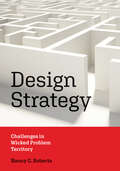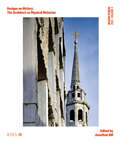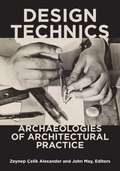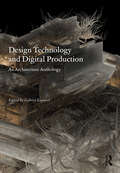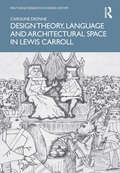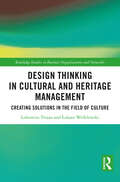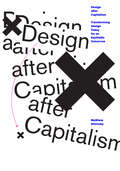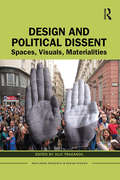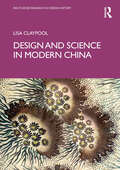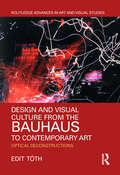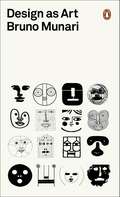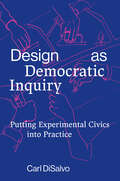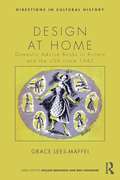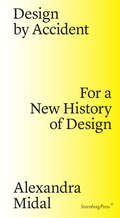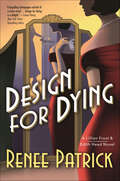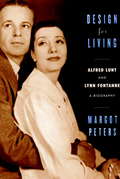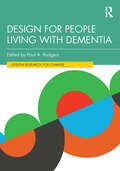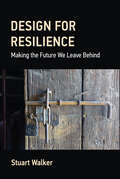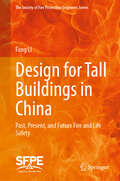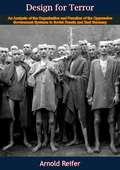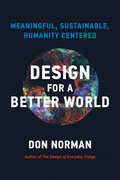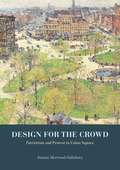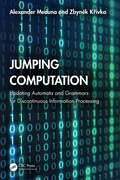- Table View
- List View
Design Strategy: Challenges in Wicked Problem Territory (Design Thinking, Design Theory)
by Nancy C. RobertsA new approach to addressing the contemporary world&’s most difficult challenges, such as climate change and poverty.Conflicts over &“the problem&” and &“the solution&” plague the modern world and land problem solvers in what has been called &“wicked problem territory&”—a social space with high levels of conflict over problems and solutions. In Design Strategy, Nancy C. Roberts proposes design as a strategy of problem solving to close the gap between an existing state and a desired state. Utilizing this approach, designers and change agents are better able to minimize self-defeating conflicts over problems and solutions, break the logjam of opposition, and avoid the traps that lock problem solvers into a never-ending cycle of conflict.Design as a field continues to grow and evolve, but Design Strategy focuses on three levels of design where &“wicked problems&” tend to lurk—strategic design (of private and public organizations), systemic design (of networked and overlapping economic, technical, political, and social subsystems), and regenerative design (of life-giving realignment between humanity and nature). Within this framework, Roberts presents refreshingly interdisciplinary case studies that integrate theory and practice across diverse fields to guide professionals in any domain—from business and nonprofit organizations to educational and healthcare systems—and finally offers hope that humanity can tackle the existential challenges we face in the twenty-first century.
Design Studio Vol. 3: The Architect as Physical Historian
by Jonathan HillEach architectural design is a new history. To identify what is novel or innovative, we need to consider the present, past and future. We expect historical narratives to be written in words, but they can also be delineated in drawing, cast in concrete or seeded in soil. The aim of this volume is to understand each design as a visible and physical history. Historical understanding is investigated as a stimulus to the creative process, highlighting how architects learn from each other and other disciplines. This encourages us to consider the stories about history that architects fabricate. An eminent set of international contributors reflect on the relevance of historical insight for contemporary design, drawing on the rich visual output of innovative studios worldwide in practice and education. Wide ranging and thought-provoking articles encompass fact, fiction, memory, time, etymology, civilisation, racial segregation and more. Features: Elizabeth Dow, Pezo von Ellrichshausen, Terunobu Fujimori, Perry Kulper, Lesley Lokko, Yeoryia Manolopoulou, Niall McLaughlin, Aisling O’Carroll, Arinjoy Sen, Amin Taha and Sumayya Vally.
Design Technics: Archaeologies of Architectural Practice
by John May Zeynep Çelik AlexanderLeading scholars historicize and theorize technology&’s role in architectural design Although the question of technics pervades the contemporary discipline of architecture, there are few critical analyses on the topic. Design Technics fills this gap, arguing that the technical dimension of design has often been flattened into the broader celebratory rhetoric of innovation. Bringing together leading scholars in architectural and design history, the volume&’s contributors situate these tools on a broader epistemological and chronological canvas. The essays here construct histories—some panoramic and others unfolding around a specific episode—of seven techniques regularly used by the designer in the architectural studio today: rendering, modeling, scanning, equipping, specifying, positioning, and repeating.Starting with observations about the epistemological changes that have unfolded in the discipline in recent decades but seeking to offer a more expansive meaning for technics, the volume casts new light on concepts such as form, experience, and image that have played central roles in historical architectural discourses. Among the questions addressed: How was the concept of form immanent in practices of scanning since the late nineteenth century? What was the historical relationship between rendering and experience in Enlightenment discourses? How did practices of specifying reconfigure the distinction between intellectual and manual labor? What kind of rationality is inherent in the designer&’s constant clicking of the mouse in front of her screen? In addressing these and other questions, this engaging and timely collection thereby proposes technics as a site for historical and philosophical reflection not only for those engaged in architectural design but also for any scholar working in the humanities today.Contributors: Lucia Allais, Edward Eigen, Orit Halpern, John Harwood, Matthew C. Hunter, and Michael Osman.
Design Technology and Digital Production: An Architecture Anthology
by Gabriel EsquivelThis book is a rigorous account of architecture’s theoretical and technological concerns over the last decade. The anthology presents projects and essays produced at the end of the first digital turn and the start of the second digital turn. This anthology engages and deploys a variety of discourses, topics, criteria, pedagogies, and technologies, including some of today’s most influential architects, practitioners, academics, and critics. It is an unflinchingly rigorous and unapologetic account of architecture’s disciplinary concerns in the last decade. This is a story that has not been told; in recent years everything has been refracted through the prism of the post-digital generation.Design Technology and Digital Production illustrates the shift to an architectural world where we can learn with and from each other, develop a community of new technologies and embrace a design ecology that is inclusive, open, and visionary. This collection fosters a sense of shared experience and common purpose, along with a collective responsibility for the well-being of the discipline of architecture as a whole.
Design Theory, Language and Architectural Space in Lewis Carroll (Routledge Research in Design History)
by Caroline DionneThis volume offers spatial theories of the emergent based on a careful close reading of the complete works of nineteenth-century writer and mathematician Lewis Carroll—from his nonsense fiction, to his work on logic and geometry, including his two short pamphlets on architecture. Drawing on selected key moments in our philosophical tradition, including phenomenology and sociospatial theories, Caroline Dionne interrogates the relationship between words and spaces, highlighting the crucial role of language in processes of placemaking. Through an interdisciplinary method that relates literary and language theories to theories of space and placemaking, with emphasis on the social and political experience of architectural spaces, Dionne investigates Carroll’s most famous children’s books, Alice’s Adventures in Wonderland and Through the Looking-Glass and What Alice Found There, in relation to his lesser-known publications on geometry and architecture. The book will be of interest to scholars working in design theory, design history, architecture, and literary theory and criticism.
Design Theory, Language and Architectural Space in Lewis Carroll (Routledge Research in Design History)
by Caroline DionneThis volume offers spatial theories of the emergent based on a careful close reading of the complete works of nineteenth-century writer and mathematician Lewis Carroll—from his nonsense fiction, to his work on logic and geometry, including his two short pamphlets on architecture. Drawing on selected key moments in our philosophical tradition, including phenomenology and sociospatial theories, Caroline Dionne interrogates the relationship between words and spaces, highlighting the crucial role of language in processes of placemaking. Through an interdisciplinary method that relates literary and language theories to theories of space and placemaking, with emphasis on the social and political experience of architectural spaces, Dionne investigates Carroll’s most famous children’s books, Alice’s Adventures in Wonderland and Through the Looking-Glass and What Alice Found There, in relation to his lesser-known publications on geometry and architecture. The book will be of interest to scholars working in design theory, design history, architecture, and literary theory and criticism.
Design Thinking in Cultural and Heritage Management: Creating Solutions in the Field of Culture (ISSN)
by Lubomira Trojan Łukasz WróblewskiThe ability to discover and respond to societal needs in the field of culture requires an integrated, interdisciplinary, and cross-sectoral approach. Such a holistic view is offered by the design thinking method, which has been extracted from the field of design and could be applied also in the sphere of culture. Interdisciplinarity and consideration of users' needs are characteristics of contemporary design and can be a significant support when faced with the challenges of cultural heritage management. The abovementioned factors act as the premise behind undertaking an analysis of the possibility of adapting the design thinking method to the management of intangible cultural heritage, and to develop a model of the design thinking process for this area. This research volume is the first comprehensive study of the application of the design thinking method to cultural management, especially management of the intangible cultural heritage. It asserts that design thinking can bring numerous benefits to organizations involved in the management of intangible cultural heritage and to its depositories. It will be of interest to researchers and academics in the fields of public and nonprofit management, strategic management, and value creation in the field of culture; students of design for culture and heritage; and practitioners in cultural management.
Design after Capitalism: Transforming Design Today for an Equitable Tomorrow
by Matthew WizinskyHow design can transcend the logics, structures, and subjectivities of capitalism: a framework, theoretical grounding, and practical principles.The designed things, experiences, and symbols that we use to perceive, understand, and perform our everyday lives are much more than just props. They directly shape how we live. In Design after Capitalism, Matthew Wizinsky argues that the world of industrial capitalism that gave birth to modern design has been dramatically transformed. Design today needs to reorient itself toward deliberate transitions of everyday politics, social relations, and economies. Looking at design through the lens of political economy, Wizinsky calls for the field to transcend the logics, structures, and subjectivities of capitalism—to combine design entrepreneurship with social empowerment in order to facilitate new ways of producing those things, symbols, and experiences that make up everyday life. After analyzing the parallel histories of capitalism and design, Wizinsky offers some historical examples of anticapitalist, noncapitalist, and postcapitalist models of design practice. These range from the British Arts and Crafts movement of the nineteenth century to contemporary practices of growing furniture or biotextiles and automated forms of production. Drawing on insights from sociology, philosophy, economics, political science, history, environmental and sustainability studies, and critical theory—fields not usually seen as central to design—he lays out core principles for postcapitalist design; offers strategies for applying these principles to the three layers of project, practice, and discipline; and provides a set of practical guidelines for designers to use as a starting point. The work of postcapitalist design can start today, Wizinsky says—with the next project.
Design and Political Dissent: Spaces, Visuals, Materialities (Routledge Research in Design Studies)
by Jilly TraganouThis book examines, through an interdisciplinary lens, the relationship between political dissent and processes of designing. In the past twenty years, theorists of social movements have noted a diversity of visual and performative manifestations taking place in protest, while the fields of design, broadly defined, have been characterized by a growing interest in activism. The book’s premise stems from the recognition that material engagement and artifacts have the capacity to articulate political arguments or establish positions of disagreement. Its contributors look at a wide array of material practices generated by both professional and nonprofessional design actors around the globe, exploring case studies that vary from street protests and encampments to design pedagogy and community-empowerment projects. For students and scholars of design studies, urbanism, visual culture, politics, and social movements, this book opens up new perspectives on design and its place in contemporary politics.
Design and Science in Modern China (Routledge Research in Design History)
by Lisa ClaypoolWhat is design in modern China? And what are the ecological stakes in understanding how modern Chinese design encourages us to see? This book takes up these questions though exploration into the work of three famous designers who were actively engaged with the natural sciences in early twentieth-century Shanghai, Canton, and Beijing.The designed objects asking for heightened vision into interior and exterior worlds make their way across temporal and cultural boundaries. This book, then, is also about that movement, and the emotions of the eye which support it. Porcelain dishes, textiles, magazine covers, and paintings moved the people who lived with them a century ago in China to an awareness of their edges, rims, borders as boundary lines, and to see things through those in-between forms from a new point of view; to share pleasure in colour and pattern, perhaps, but also to connect to other deeply transformative feelings at the boundary.The book will be of interest to scholars working in design history, art history, and Chinese studies.
Design and Visual Culture from the Bauhaus to Contemporary Art: Optical Deconstructions (Routledge Advances in Art and Visual Studies)
by Edit TóthThis book complements the more textually-based Bauhaus scholarship with a practice-oriented and creative interpretive method, which makes it possible to consider Bauhaus-related works in an unconventional light. Edit Toth argues that focusing on the functionalist approach of the Bauhaus has hindered scholars from properly understanding its design work. With a global scope and under-studied topics, the book advances current scholarly discussions concerning the relationship between image technologies and the body by calling attention to the materiality of image production and strategies of re-channeling image culture into material processes and physical body space, the space of dimensionality and everyday activity.
Design as Art (Penguin Modern Classics)
by Bruno MunariHow do we see the world around us? The Penguin on Design series includes the works of creative thinkers whose writings on art, design and the media have changed our vision forever. Bruno Munari was among the most inspirational designers of all time, described by Picasso as ‘the new Leonardo’. Munari insisted that design be beautiful, functional and accessible, and this enlightening and highly entertaining book sets out his ideas about visual, graphic and industrial design and the role it plays in the objects we use everyday. Lamps, road signs, typography, posters, children’s books, advertising, cars and chairs – these are just some of the subjects to which he turns his illuminating gaze.
Design as Democratic Inquiry: Putting Experimental Civics into Practice
by Carl DisalvoThrough practices of collaborative imagination and making, or "doing design otherwise,&” design experiments can contribute to keeping local democracies vibrant.In this counterpoint to the grand narratives of design punditry, Carl DiSalvo presents what he calls &“doing design otherwise.&” Arguing that democracy requires constant renewal and care, he shows how designers can supply novel contributions to local democracy by drawing together theory and practice, making and reflection. The relentless pursuit of innovation, uncritical embrace of the new and novel, and treatment of all things as design problems, says DiSalvo, can lead to cultural imperialism. In Design as Democratic Inquiry, he recounts a series of projects that exemplify engaged design in practice. These experiments in practice-based research are grounded in collaborations with communities and institutions. The projects DiSalvo describes took place from 2014 to 2019 in Atlanta. Rather than presume that government, industry—or academia—should determine the outcome, the designers began with the recognition that the residents and local organizations were already creative and resourceful. DiSalvo uses the projects to show how design might work as a mode of inquiry. Resisting heroic stories of design and innovation, he argues for embracing design as fragile, contingent, partial, and compromised. In particular, he explores how design might be leveraged to facilitate a more diverse civic imagination. A fundamental tenet of design is that the world is made, and therefore it could be made differently. A key concept is that democracy requires constant renewal and care. Thus, designing becomes a way to care, together, for our collective future.
Design at Home: Domestic Advice Books in Britain and the USA since 1945 (Directions In Cultural History Ser.)
by Grace Lees MaffeiDomestic advice literature is rich in information about design, ideals of domesticity, consumption and issues of identity, yet this literature remains a relatively neglected resource in comparison with magazines and film. Design at Home brings together etiquette, homemaking and home decoration advice as sources in the first systematic demonstration of the historical value of domestic advice literature as a genre of word and image, and a discourse of dominance. This book traces a transatlantic domestic dialogue between the UK and the US as the chapters explore issues of design, domesticity, consumption, social interaction and identity markers including class, gender and age. Areas covered include: • the use of domestic advice by historians • relationships between advice, housing and the middle class • links between advice and gender • advice and the teenage consumer Design at Home is essential reading for students and scholars of cultural and social history, design history, and cultural studies.
Design by Accident: For a New History of Design
by Alexandra MidalA counterhistory and new historiography of design.In Design by Accident, Alexandra Midal declares the autonomy of design, in and on its own terms. This meticulously researched work proposes not only a counterhistory but a new historiography of design, shedding light on overlooked historical landmarks and figures while reevaluating the legacies of design's established luminaries from the nineteenth century to the present. Midal rejects both linear narratives of progress and the long-held perception of design as a footnote to the histories of fine art and architecture. By weaving critical analysis of the canon of design history and theory together, with special attention to the writings of designers themselves, she draws out the nuances and radical potentials of the discipline—from William Morris's ambivalence toward industry, to Catharine Beecher's proto-feminist household appliances, to the Bauhaus's Expressionist origins, and the influence of Herbert Marcuse on Joe Colombo.
Design for Dying: A Lillian Frost And Edith Head Novel (Lillian Frost & Edith Head #1)
by Renee PatrickThe first in a series of riveting behind-the-scenes mysteries, Renee Patrick's Design for Dying is a delightful romp through Hollywood's Golden Age.Los Angeles, 1937. Lillian Frost has traded dreams of stardom for security as a department store salesgirl . . . until she discovers she's a suspect in the murder of her former roommate, Ruby Carroll. Party girl Ruby died wearing a gown she stole from the wardrobe department at Paramount Pictures, domain of Edith Head.Edith has yet to win the first of her eight Academy Awards; right now she's barely hanging on to her job, and a scandal is the last thing she needs. To clear Lillian's name and save Edith's career, the two women join forces. Unraveling the mystery pits them against a Hungarian princess on the lam, a hotshot director on the make, and a private investigator who's not on the level. All they have going for them are dogged determination, assists from the likes of Bob Hope and Barbara Stanwyck, and a killer sense of style. In show business, that just might be enough.At the Publisher's request, this title is being sold without Digital Rights Management Software (DRM) applied.
Design for Liberty: Private Property, Public Administration, and the Rule of Law
by Richard A. EpsteinFollowing a vast expansion in the twentieth century, government is beginning to creak at the joints under its enormous weight. The signs are clear: a bloated civil service, low approval ratings for Congress and the President, increasing federal-state conflict, rampant distrust of politicians and government officials, record state deficits, and major unrest among public employees. In this compact, clearly written book, the noted legal scholar Richard Epstein advocates a much smaller federal government, arguing that our over-regulated state allows too much discretion on the part of regulators, which results in arbitrary, unfair decisions, rent-seeking, and other abuses. Epstein bases his classical liberalism on the twin pillars of the rule of law and of private contracts and property rights—an overarching structure that allows private property to keep its form regardless of changes in population, tastes, technology, and wealth. This structure also makes possible a restrained public administration to implement limited objectives. Government continues to play a key role as night-watchman, but with the added flexibility in revenues and expenditures to attend to national defense and infrastructure formation. Although no legal system can eliminate the need for discretion in the management of both private and public affairs, predictable laws can cabin the zone of discretion and permit arbitrary decisions to be challenged. Joining a set of strong property rights with sound but limited public administration could strengthen the rule of law, with its virtues of neutrality, generality, clarity, consistency, and forward-lookingness, and reverse the contempt and cynicism that have overcome us.
Design for Living: Alfred Lunt and Lynn Fontanne
by Margot PetersFrom the much-admired biographer of Charlotte Brontë, Mrs. Patrick Campbell, and the Barrymores ("Margot Peters is surely now . . . our foremost historian of stage make-believe"--Leon Edel), a new biography of the most famous English-speaking acting team of the twentieth century. Individually, they were recognized as extraordinary actors, each one a star celebrated, imitated, sought after. Together, they were legend. The Lunts. A name to conjure with. Alfred Lunt and Lynn Fontanne worked together so imaginatively, so seamlessly onstage that they seemed to fuse into one person. Offstage, they brawled so famously and raucously over every detail of every performance that they inspired the musical Kiss Me, Kate. At home on Broadway, in London's West End, touring the United States and Great Britain, and even playing "the foxhole circuit" of World War II, the Lunts stunned, moved, and mystified audiences for more than four decades. They were considered to be a rarefied taste, but when they toured Texas in the 1930s, the audience threw cowboy hats onto the stage. Their private life was equally fascinating, as unusual as the one they led in public. Friends like the critic Alexander Woollcott (whom Edna Ferber once described as "the little New Jersey Nero who thinks his pinafore is a toga"), Noël Coward, Laurette Taylor, and Sidney Greenstreet received lifelong loyalty and hospitality. Ten Chimneys, their country home in Genesee Depot, Wisconsin, "is to performers what the Vatican is to Catholics," Carol Channing once said. "The Lunts are where we all spring from. " In this new biography, Margot Peters catches the magic of Lunt and Fontanne--their period, their work, their intimacy and its contradictions--with candor, delicacy, intelligence, and wit. She writes about their personal and creative choices as deftly as she captures their world, from their meeting (backstage, naturally)--when Fontanne was a young actress in the first flush of stardom and Lunt a lanky midwesterner who came in the stage door, bowed to her elaborately, lost his balance, and fell down the stairs--and the early days when an unknown and very hungry Noël Coward lived in a swank hotel in a room the size of a closet and cadged meals at their table to the telegram the famous couple once sent to a movie mogul, turning down a studio contract worth a fortune ("We can be bought, my dear Mr. Laemmle, but we can't be bored"). We follow the Lunts through triumphs in plays such as The Guardsman, The Taming of the Shrew, and Design for Living; through friendships and feuds; through the intricate way they worked with such playwrights and directors as S. N. Behrman, Robert Sherwood, Giraudoux, Dürrenmatt, Peter Brook, and with each other. Margot Peters captures the gallantry of two remarkably gifted people who lived for their art and for each other. Alfred Lunt and Lynn Fontanne were once described as an "amazing duet of intelligence and gaiety. " Margot Peters re-creates the fun and the fireworks. From the Hardcover edition.
Design for People Living with Dementia (Design Research for Change)
by Paul A. RodgersThis book presents the latest research that shows how design thinking, making, and acting contribute to the co-designing and development of products, spaces, and services with people living with dementia. We know that there is currently no cure for the 130+ kinds of dementia that millions of people live with all over the world, but the designed interventions such as the products, spaces, and services described in this book can address stigma, isolation, loss of confidence, and raise awareness and greater understanding of dementia. This book showcases a range of innovative and creative design interventions that have been developed to break the cycle of well-established opinions, strategies, mindsets, and ways of doing that tend to remain unchallenged in the health and social care of people living with dementia. The book will be of interest to scholars working in product design, service design, experience design, architecture, design research, information design, user-centred design, and design for health.
Design for Resilience: Making the Future We Leave Behind
by Stuart WalkerA beautifully written and illustrated framework for resilient design that is as pragmatic as it is inspiring, showing us not only how but why we should design differently.Design for Resilience is a timely, visionary map for creating restorative design that addresses humanity&’s most critical issue: climate change. Our current wealth-oriented economic systems have resulted in gross disparities, war, refugee crises, and mass migrations that augur a bleak collective future. In this book, respected scholar Stuart Walker combines formidable research with practical examples to offer a hopeful, original, and transformative view of what resilient design looks like and how it can apply to all aspects of life, from personal objects to food to culture to business to recreation.Working at the intersection of theory, philosophy, history, environmentalism, and justice, Walker offers a fresh approach that decolonizes design thinking to fundamentally change the nature of design practice and how it shapes our lives, communities, and industries. Asking nothing short of the fundamental question &“How should we live?,&” Design for Resilience addresses the high-priority issues that concern governments, policymakers, designers, and people around the world who recognize that now, perhaps more than at any other time in human history, we need paradigmatic changes to create a future that lasts.
Design for Tall Buildings in China: Past, Present, and Future Fire and Life Safety (The Society of Fire Protection Engineers Series)
by Fang LIThis book provides readers an approach to overall fire and life-life design of high-rise buildings in a way that meets all stakeholders’ objectives. It describes how China began constructing tall and super tall buildings decades ago and imparts many lessons learned through those experiences along with similar projects from all over the world. The author explains the technology and culture for tall building design in China as a context for how the world seeks to ensure fire and life safety in these remarkable structures.
Design for Terror: An Analysis of the Organization and Function of the Oppressive Government Systems in Soviet Russia and Nazi Germany
by Arnold ReiferTHE TITLE OF this study unfortunately implies much and tells little. The scope of any work such as this must of necessity be limited to certain aspects only of the regimes in question. The formation and political history of the Nazi and Soviet regimes, for example, have been covered only in the most cursory manner, and only insofar as they bore a direct relationship to the network of terror which evolved in both states.The historical period herein covered is approximately 1932 to 1941 for Germany and 1918 to 1958 for Soviet Russia. Emphasis has been placed on the Soviet model, which is the more contemporary of the two. The history, scope and function of the Nazi secret police will, however, be discussed where it can be shown that a similarity or a contrast existed with respect to the organs of repression in Russia.In addition to a discussion of the terror itself, mention will also be made of the background, methods, goals and actual operations of the instruments of terror. I have tried, to the best of my ability, to preserve the continuity throughout the text and to avoid “skipping” from the Gestapo in one paragraph to the N.K.V.D. in the other. A conscious attempt has been made not only to examine the system of terror in and for itself but also to discover the significance of terror in the daily life of the average citizen as well as to ascertain to what extent terror represents an inevitable feature of totalitarian societies.”—Arnold Reifer
Design for a Better World: Meaningful, Sustainable, Humanity Centered
by Donald A. NormanHow human behavior brought our world to the brink, and how human behavior can save us.The world is a mess. Our dire predicament, from collapsing social structures to the climate crisis, has been millennia in the making and can be traced back to the erroneous belief that the earth&’s resources are infinite. The key to change, says Don Norman, is human behavior, covered in the book&’s three major themes: meaning, sustainability, and humanity-centeredness. Emphasize quality of life, not monetary rewards; restructure how we live to better protect the environment; and focus on all of humanity. Design for a Better World presents an eye-opening diagnosis of where we&’ve gone wrong and a clear prescription for making things better.Norman proposes a new way of thinking, one that recognizes our place in a complex global system where even simple behaviors affect the entire world. He identifies the economic metrics that contribute to the harmful effects of commerce and manufacturing and proposes a recalibration of what we consider important in life. His experience as both a scientist and business executive gives him the perspective to show how to make these changes while maintaining a thriving economy. Let the change begin with this book before it&’s too late
Design for the Crowd: Patriotism and Protest in Union Square
by Joanna Merwood-SalisburySituated on Broadway between Fourteenth and Seventeenth Streets, Union Square occupies a central place in both the geography and the history of New York City. Though this compact space was originally designed in 1830 to beautify a residential neighborhood and boost property values, by the early days of the Civil War, New Yorkers had transformed Union Square into a gathering place for political debate and protest. As public use of the square changed, so, too, did its design. When Frederick Law Olmsted and Calvert Vaux redesigned the park in the late nineteenth century, they sought to enhance its potential as a space for the orderly expression of public sentiment. A few decades later, anarchists and Communist activists, including Emma Goldman, turned Union Square into a regular gathering place where they would advocate for radical change. In response, a series of city administrations and business groups sought to quash this unruly form of dissidence by remaking the square into a new kind of patriotic space. As Joanna Merwood-Salisbury shows us in Design for the Crowd, the history of Union Square illustrates ongoing debates over the proper organization of urban space—and competing images of the public that uses it. In this sweeping history of an iconic urban square, Merwood-Salisbury gives us a review of American political activism, philosophies of urban design, and the many ways in which a seemingly stable landmark can change through public engagement and design. Published with the support of Furthermore: a program of the J. M. Kaplan Fund.
Design for the Unthinkable World: Strange Ecology and Unwelcome Change (Design Research for Change)
by Craig Bremner Giovanni Innella A. Paul RodgersThis edited book contests that if design’s raison d'être is to make things better, then the object of design has always been, remains and can only be a changed world and our relationship to it – the world-for-us.Each chapter was written by carefully selected researchers and practitioners who span geographical, disciplinary, and methodological boundaries in their work. Contributors skilfully examine the case that, while this once might have been seen to be a worthy objective (how else to effect a preferred state and/or pursue the project for the better world?), now the role of designing must cease to service design for change in the manner in which it has been doing. Chapters explore how designing itself might change to explore the possibilities that might exist for the design of what-might-not-become in an unthinkable-world; what Eugene Thacker calls a world-without-us. This world-without-us does not mean a world devoid of humans or an interstellar world, but a world we project that continues to revolve around the sun but no longer revolves around us.This book will be of interest to scholars working in design research, design ecology, product design, service design, experience design, architecture, and information design.
